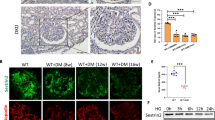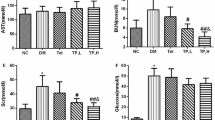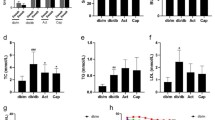Abstract
Podocyte injury plays a critical role in the development and progression of diabetic nephropathy (DN). Over expression of TRPC6 on the podocytes has been revealed to cause podocyte injury in non-diabetic states. Besides, the emerging evidence from clinic revealed that vitamin D could reduce albuminuria and improve renal function, which was associated with podocyte protection. Our study aimed to investigate whether calcitriol ameliorating podocyte impairment is associated with regulation of the expression of TRPC6 in STZ-induced rats. Sprague-Dawley rats were randomly divided into three groups: normal control, DN, and DN treated with calcitriol (DN + VD); VD rats were treated with 0.1 μg/kg/d calcitriol by gavage. DN model rats were established by intraperitoneal injections of streptozocin. The rats were sacrificed after 18 weeks treatment. DN rats exhibited increased proteinuria accompanied by elevated TRPC6 expression. Treatment with calcitriol not only reduced proteinuria, but also normalized TRPC6 expression. Meanwhile, in DN rats, the expression of podocyte specific markers including nephrin and podocin was significantly decreased, accompanied by increased desmin, a marker of podocyte injury. Treatment with calcitriol reversed above changes. In addition, vitamin D receptor (VDR) was significantly decreased, whereas this reduction was attenuated by the calcitriol treatment. Moreover, TRPC6 was positively correlated with both 24 h urinary protein and desmin. In contrast, TRPC6 was negatively correlated with both VDR and nephrin expression in podocytes. Calcitriol can ameliorate podocyte injury, which is contributed by the inhibition of enhanced TRPC6 expression in the early stages of DN rats.







Similar content being viewed by others
References
Xu Y, Wang L, He J, Bi Y, Li M, Wang T, Jiang Y, Dai M, Lu J, Xu M, Li Y, Hu N, Li J, Mi S, Chen CS, Li G, Mu Y, Zhao J, Kong L, Chen J, Lai S, Wang W, Zhao W, Ning G (2013) Prevalence and control of diabetes in Chinese adults. JAMA 310:948–959
Reddy GR, Kotlyarevska K, Ransom RF, Menon RK (2008) The podocyte and diabetes mellitus: is the podocyte the key to the origins of diabetic nephropathy? Curr Opin Nephrol Hypertens 17:32–36
Kumar PA, Brosius FC, Menon RK (2011) The glomerular podocyte as a target of growth hormone action: implications for the pathogenesis of diabetic nephropathy. Curr Diabetes Rev 7:50–55
Han H, Wang Y, Li X, Wang PA, Wei X, Liang W, Ding G, Yu X, Bao C, Zhang Y, Wang Z, Yi F (2013) Novel role of NOD2 in mediating Ca2+ signaling: evidence from NOD2-regulated podocyte TRPC6 channels in hyperhomocysteinemia. Hypertension 62:506–511
Dryer SE, Reiser J (2010) TRPC6 channels and their binding partners in podocytes: role in glomerular filtration and pathophysiology. Am J Physiol Renal Physiol 299:F689–F701
Liu BC, Song X, Lu XY, Li DT, Eaton DC, Shen BZ, Li XQ, Ma HP (2013) High glucose induces podocyte apoptosis by stimulating TRPC6 via elevation of reactive oxygen species. Biochim Biophys Acta 1833:1434–1442
Li Z, Xu J, Xu P, Liu S, Yang Z (2013) Wnt/beta-catenin signalling pathway mediates high glucose induced cell injury through activation of TRPC6 in podocytes. Cell Prolif 46:76–85
Fornoni A (2010) Proteinuria, the podocyte, and insulin resistance. N Engl J Med 363:2068–2069
Reiser J, Polu KR, Moller CC, Kenlan P, Altintas MM, Wei C, Faul C, Herbert S, Villegas I, Avila-Casado C, McGee M, Sugimoto H, Brown D, Kalluri R, Mundel P, Smith PL, Clapham DE, Pollak MR (2005) TRPC6 is a glomerular slit diaphragm-associated channel required for normal renal function. Nat Genet 37:739–744
Eckel J, Lavin PJ, Finch EA, Mukerji N, Burch J, Gbadegesin R, Wu G, Bowling B, Byrd A, Hall G, Sparks M, Zhang ZS, Homstad A, Barisoni L, Birbaumer L, Rosenberg P, Winn MP (2011) TRPC6 enhances angiotensin II-induced albuminuria. J Am Soc Nephrol 22:526–535
Kim EY, Anderson M, Dryer SE (2012) Insulin increases surface expression of TRPC6 channels in podocytes: role of NADPH oxidases and reactive oxygen species. Am J Physiol Renal Physiol 302:F298–F307
Liu D, Zhu Z, Tepel M (2008) The role of transient receptor potential channels in metabolic syndrome. Hypertens Res 31:1989–1995
Evans JF, Lee JH, Ragolia L (2009) Ang-II-induced Ca(2+) influx is mediated by the 1/4/5 subgroup of the transient receptor potential proteins in cultured aortic smooth muscle cells from diabetic Goto-Kakizaki rats. Mol Cell Endocrinol 302:49–57
Woudenberg-Vrenken TE, Bindels RJ, Hoenderop JG (2009) The role of transient receptor potential channels in kidney disease. Nat Rev Nephrol 5:441–449
Graham S, Gorin Y, Abboud HE, Ding M, Lee DY, Shi H, Ding Y, Ma R (2011) Abundance of TRPC6 protein in glomerular mesangial cells is decreased by ROS and PKC in diabetes. Am J Physiol Cell Physiol 301:C304–C315
Moller CC, Flesche J, Reiser J (2009) Sensitizing the slit diaphragm with TRPC6 ion channels. J Am Soc Nephrol 20:950–953
Winn MP, Conlon PJ, Lynn KL, Farrington MK, Creazzo T, Hawkins AF, Daskalakis N, Kwan SY, Ebersviller S, Burchette JL, Pericak-Vance MA, Howell DN, Vance JM, Rosenberg PB (2005) A mutation in the TRPC6 cation channel causes familial focal segmental glomerulosclerosis. Science 308:1801–1804
Moller CC, Wei C, Altintas MM, Li J, Greka A, Ohse T, Pippin JW, Rastaldi MP, Wawersik S, Schiavi S, Henger A, Kretzler M, Shankland SJ, Reiser J (2007) Induction of TRPC6 channel in acquired forms of proteinuric kidney disease. J Am Soc Nephrol 18:29–36
Sonneveld R, Ferre S, Hoenderop JG, Dijkman HB, Berden JH, Bindels RJ, Wetzels JF, van der Vlag J, Nijenhuis T (2013) Vitamin D down-regulates TRPC6 expression in podocyte injury and proteinuric glomerular disease. Am J Pathol 182:1196–1204
Wang Y, Deb DK, Zhang Z, Sun T, Liu W, Yoon D, Kong J, Chen Y, Chang A, Li YC (2012) Vitamin D receptor signaling in podocytes protects against diabetic nephropathy. J Am Soc Nephrol 23:1977–1986
Sugimoto H, LeBleu VS, Bosukonda D, Keck P, Taduri G, Bechtel W, Okada H, Carlson W Jr, Bey P, Rusckowski M, Tampe B, Tampe D, Kanasaki K, Zeisberg M, Kalluri R (2012) Activin-like kinase 3 is important for kidney regeneration and reversal of fibrosis. Nat Med 18:396–404
Pan MM, Zhang MH, Ni HF, Chen JF, Xu M, Phillips AO, Liu BC (2013) Inhibition of TGF-beta1/Smad signal pathway is involved in the effect of Cordyceps sinensis against renal fibrosis in 5/6 nephrectomy rats. Food Chem Toxicol 58:487–494
Sanden SK, Wiggins JE, Goyal M, Riggs LK, Wiggins RC (2003) Evaluation of a thick and thin section method for estimation of podocyte number, glomerular volume, and glomerular volume per podocyte in rat kidney with Wilms’ tumor-1 protein used as a podocyte nuclear marker. J Am Soc Nephrol 14:2484–2493
Guo JK, Menke AL, Gubler MC, Clarke AR, Harrison D, Hammes A, Hastie ND, Schedl A (2002) WT1 is a key regulator of podocyte function: reduced expression levels cause crescentic glomerulonephritis and mesangial sclerosis. Hum Mol Genet 11:651–659
Jefferson JA, Shankland SJ, Pichler RH (2008) Proteinuria in diabetic kidney disease: a mechanistic viewpoint. Kidney Int 74:22–36
Tan AL, Forbes JM, Cooper ME (2007) AGE, RAGE, and ROS in diabetic nephropathy. Semin Nephrol 27:130–143
Bouillon R, Carmeliet G, Verlinden L, van Etten E, Verstuyf A, Luderer HF, Lieben L, Mathieu C, Demay M (2008) Vitamin D and human health: lessons from vitamin D receptor null mice. Endocr Rev 29:726–776
Holick MF (2007) Vitamin D deficiency. N Engl J Med 357:266–281
Al-Badr W, Martin KJ (2008) Vitamin D and kidney disease. Clin J Am Soc Nephrol 3:1555–1560
Jones G (2007) Expanding role for vitamin D in chronic kidney disease: importance of blood 25-OH-D levels and extra-renal 1alpha-hydroxylase in the classical and nonclassical actions of 1alpha,25-dihydroxyvitamin D(3). Semin Dial 20:316–324
Teng M, Wolf M, Lowrie E, Ofsthun N, Lazarus JM, Thadhani R (2003) Survival of patients undergoing hemodialysis with paricalcitol or calcitriol therapy. N Engl J Med 349:446–456
de Zeeuw D, Agarwal R, Amdahl M, Audhya P, Coyne D, Garimella T, Parving HH, Pritchett Y, Remuzzi G, Ritz E, Andress D (2010) Selective vitamin D receptor activation with paricalcitol for reduction of albuminuria in patients with type 2 diabetes (VITAL study): a randomised controlled trial. Lancet 376:1543–1551
Fernandez-Juarez G, Luno J, Barrio V, de Vinuesa SG, Praga M, Goicoechea M, Lahera V, Casas L, Oliva J (2013) 25 (OH) vitamin D levels and renal disease progression in patients with type 2 diabetic nephropathy and blockade of the renin–angiotensin system. Clin J Am Soc Nephrol 8:1870–1876
Mizobuchi M, Morrissey J, Finch JL, Martin DR, Liapis H, Akizawa T, Slatopolsky E (2007) Combination therapy with an angiotensin-converting enzyme inhibitor and a vitamin D analog suppresses the progression of renal insufficiency in uremic rats. J Am Soc Nephrol 18:1796–1806
He W, Kang YS, Dai C, Liu Y (2011) Blockade of Wnt/beta-catenin signaling by paricalcitol ameliorates proteinuria and kidney injury. J Am Soc Nephrol 22:90–103
Kiekhaefer CM, Weber B, Huggins M, Gorichanaz C, Nehring JA, DeLuca HF (2011) 2alpha-Methyl-19-nor-(20S)-1,25-dihydroxyvitamin D(3) protects the insulin 2 knockout non-obese diabetic mouse from developing type 1 diabetes without hypercalcaemia. Clin Exp Immunol 166:325–332
Goel M, Sinkins WG, Zuo CD, Estacion M, Schilling WP (2006) Identification and localization of TRPC channels in the rat kidney. Am J Physiol Renal Physiol 290:F1241–F1252
Hsu YJ, Hoenderop JG, Bindels RJ (2007) TRP channels in kidney disease. Biochim Biophys Acta 1772:928–936
Huber TB, Schermer B, Benzing T (2007) Podocin organizes ion channel-lipid supercomplexes: implications for mechanosensation at the slit diaphragm. Nephron Exp Nephrol 106:e27–e31
Schlondorff J, Del Camino D, Carrasquillo R, Lacey V, Pollak MR (2009) TRPC6 mutations associated with focal segmental glomerulosclerosis cause constitutive activation of NFAT-dependent transcription. Am J Physiol Cell Physiol 296:C558–C569
Chiluiza D, Krishna S, Schumacher VA, Schlondorff J (2013) Gain-of-function mutations in transient receptor potential C6 (TRPC6) activate extracellular signal-regulated kinases 1/2 (ERK1/2). J Biol Chem 288:18407–18420
Faul C, Donnelly M, Merscher-Gomez S, Chang YH, Franz S, Delfgaauw J, Chang JM, Choi HY, Campbell KN, Kim K, Reiser J, Mundel P (2008) The actin cytoskeleton of kidney podocytes is a direct target of the antiproteinuric effect of cyclosporine A. Nat Med 14:931–938
Wang Y, Ding M, Chaudhari S, Ding Y, Yuan J, Stankowska D, He S, Krishnamoorthy R, Cunningham JT, Ma R (2013) Nuclear factor kappaB mediates suppression of canonical transient receptor potential 6 expression by reactive oxygen species and protein kinase C in kidney cells. J Biol Chem 288:12852–12865
Anderson M, Roshanravan H, Khine J, Dryer SE (2014) Angiotensin II activation of TRPC6 channels in rat podocytes requires generation of reactive oxygen species. J Cell Physiol 229:434–442
Thilo F, Lee M, Xia S, Zakrzewicz A, Tepel M (2014) High glucose modifies transient receptor potential canonical type 6 channels via increased oxidative stress and syndecan-4 in human podocytes. Biochem Biophys Res Commun 450:312–317
Freundlich M, Quiroz Y, Zhang Z, Zhang Y, Bravo Y, Weisinger JR, Li YC, Rodriguez-Iturbe B (2008) Suppression of renin–angiotensin gene expression in the kidney by paricalcitol. Kidney Int 74:1394–1402
Xiao H, Shi W, Liu S, Wang W, Zhang B, Zhang Y, Xu L, Liang X, Liang Y (2009) 1,25-Dihydroxyvitamin D(3) prevents puromycin aminonucleoside-induced apoptosis of glomerular podocytes by activating the phosphatidylinositol 3-kinase/Akt-signaling pathway. Am J Nephrol 30:34–43
Haussler MR, Jurutka PW, Mizwicki M, Norman AW (2011) Vitamin D receptor (VDR)-mediated actions of 1alpha,25(OH)(2) vitamin D(3): genomic and non-genomic mechanisms. Best Pract Res Clin Endocrinol Metab 25:543–559
Acknowledgments
This work was supported by Grants from the National Natural Science Foundation of China (No. 81370826), Medical Key Talents Programs of Jiangsu Province (RC2011124) and the Fundamental Research Funds for the Central Universities (CXLX13_122).
Author information
Authors and Affiliations
Corresponding author
Additional information
Xiaoliang Zhang and Zhixia Song have contributed equally to this work.
Rights and permissions
About this article
Cite this article
Zhang, X., Song, Z., Guo, Y. et al. The novel role of TRPC6 in vitamin D ameliorating podocyte injury in STZ-induced diabetic rats. Mol Cell Biochem 399, 155–165 (2015). https://doi.org/10.1007/s11010-014-2242-9
Received:
Accepted:
Published:
Issue Date:
DOI: https://doi.org/10.1007/s11010-014-2242-9




